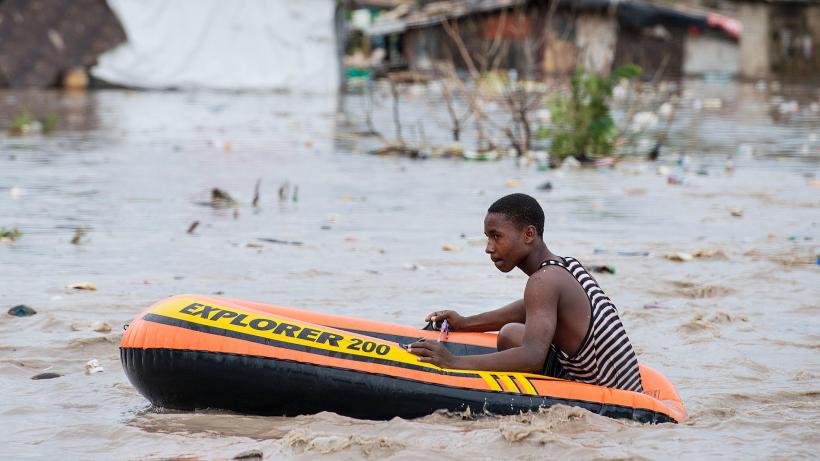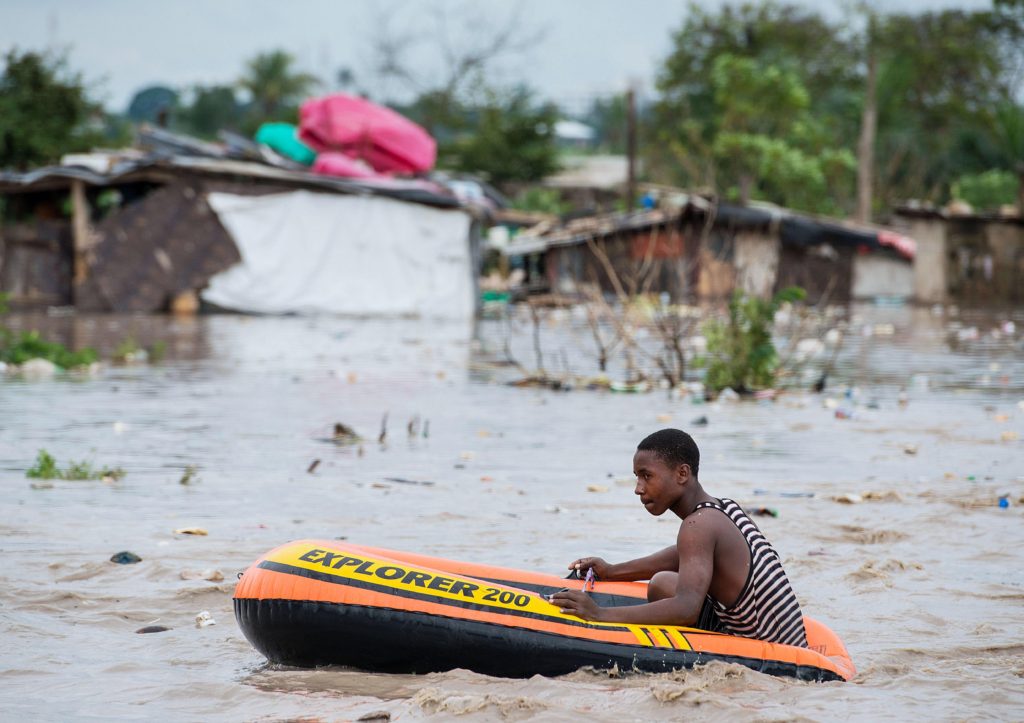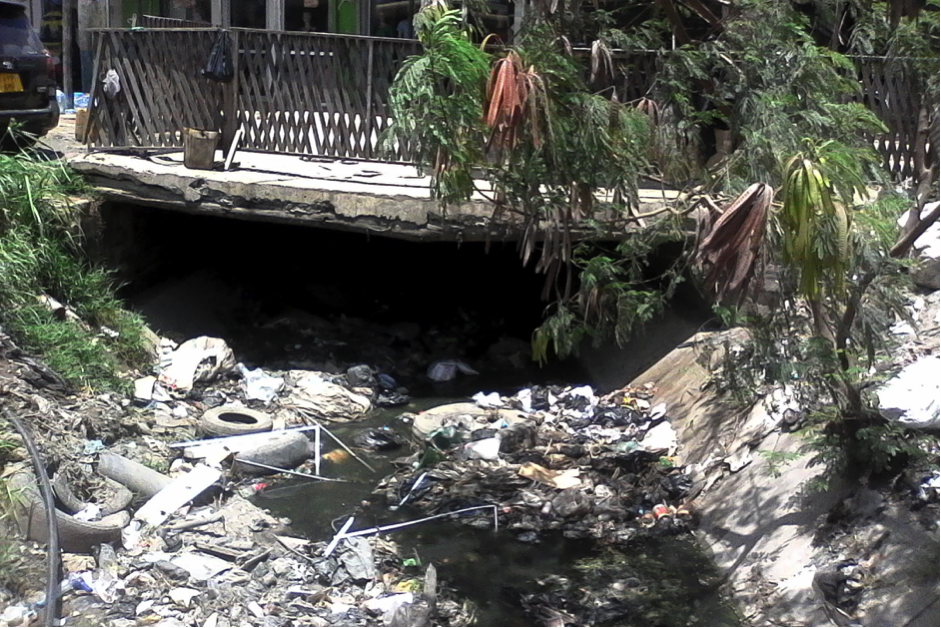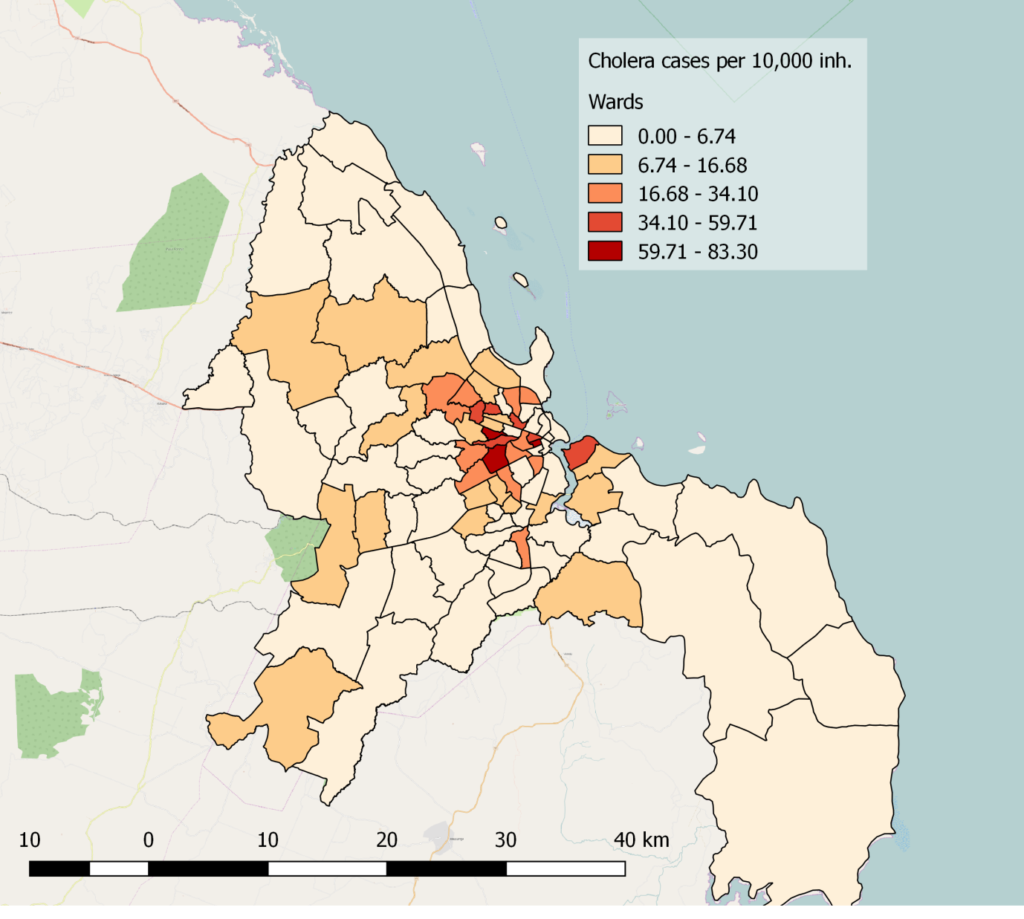
A call for resilient cities: Weather shocks & disease in Dar es Salaam
A recent IGC Working Paper looks at the relationship between extreme rainfall, flooding, infrastructure and cholera incidence in Dar es Salaam.
Climate change will have a significant impact on the lives of the poor in the years ahead as extreme weather events, such as floods, heavy precipitation and droughts, are expected to become more frequent. As cities in sub-Saharan Africa (SSA) continue to urbanize at an unprecedented pace, the question of how their urban dwellers are impacted by weather shocks is becoming increasingly relevant. Poor infrastructure, limited public service provision, and informality puts many residents at risk of weather variability (Figure 1). The World Bank (2016) estimates that climate change may push up to 77 million more urban residents into poverty by 2030.
The health outcomes of climate change
Looking at health outcomes of climate change is important. Contagion is one “downside of density” (Glaeser & Sims 2015). Throughout history, cities with low-quality infrastructure and poor sanitation have been pockets of epidemics (i.e. 19th century London or Paris). Poor health and disease not only lower productivity in the short-term, they also hinder long-term economic growth. This study makes progress on this issue by looking at the effect of rainfall, flooding and infrastructure provision on cholera incidence in Dar es Salaam.
[caption id="attachment_22623" align="aligncenter" width="1024"] Figure 1: Flooding due to heavy rain in Dar es Salaam (Credit: Daniel Hayduk/AFP/Getty Images)[/caption]
Figure 1: Flooding due to heavy rain in Dar es Salaam (Credit: Daniel Hayduk/AFP/Getty Images)[/caption]
Cholera in Dar es Salaam
Dar es Salaam is one of the largest cities in eastern Africa, with a population of over 4.4 million. Rapid urbanisation has led to great infrastructure deficits. Close to 70% of residents live in informal settlements without adequate access to clean water, proper drainage system and waste collection. Only 50% has access to improved sanitation. The city’s geography and coastal positioning makes it vulnerable to climatic hazards. Combined with high informality, it is highly prone to flooding, exposing residents to health hazards from vector-borne diseases (World Bank 2017).
Cholera is an acute diarrhoeal infection caused by the ingestion of food or water contaminated with the vibrio cholera. It can affect both children and adults and kill within hours if left untreated. Roughly 1.3 to 4.0 million cases are recorded yearly worldwide. Cholera is endemic in Tanzania. During the 2015-2016 outbreak, there were over 24,000 recorded cases; with more than a fifth in Dar es Salaam.
Weather and health shocks in urban areas
Weather shocks can affect human health through two main channels (Burgess et al. 2017):
- Direct mechanisms: through increased contact with pathogens. Heavy rainfall and flooding have been associated with a higher likelihood of cholera outbreaks. Surface runoff from point sources – such as pit-latrines – may increase the contamination of water sources; and water stagnation may lead to increased exposure to cholera vibrios (Osei et al. 2010). Given the city’s poor quality storm-water drains, which are frequently blocked by unregulated waste dumping (Figure 2), heavy rainfall quickly leads to flooding, increasing the risk of contamination.
- Indirect mechanisms: through negative income-shocks. For instance, flooding and heavy rainfall may significantly affect accessibility to jobs in contexts of poor road infrastructure. The negative income shock can then lead to reduced consumption of healthier, quality goods such as clean water, and increase the risk of contamination. Behavioural changes during periods of weather shocks may also increase the probability of contagion (The World Health Organisation).
[caption id="attachment_22625" align="aligncenter" width="941"] Figure 2: Construction over streams in Sinza Mori. Image credit: Ramani Huria[/caption]
Figure 2: Construction over streams in Sinza Mori. Image credit: Ramani Huria[/caption]
Data: cholera cases, rainfall and geography
For this study, we obtained data from Dar es Salaam Regional and Municipal Medical Offices, consisting of weekly cholera cases in all wards of the city during the 2015-16 outbreak (Figure 3). This data, covering all weeks between March 2015 and September 2016, was combined with satellite measures of weekly accumulated rainfall for the same wards. We added information on local infrastructure and ward characteristics from other sources. Mostly, we use OpenStreetMap (OSM) data collected by the NGO Dar Ramani Huria. They use drone imagery and other techniques to map residential areas, roads, floodplains, and model flood risk across Dar es Salaam.
[caption id="attachment_22627" align="aligncenter" width="1024"] Figure 3: Total cholera cases per 10,000 inhabitants during 2015-16 outbreak.[/caption]
Figure 3: Total cholera cases per 10,000 inhabitants during 2015-16 outbreak.[/caption]
Findings
There are four key findings in this study:
We find robust evidence that heavy rainfall has a strong positive effect on the weekly cholera occurrence within wards of Dar es Salaam. On average, a 10mm increase in weekly rainfall leads to an increase of up to 3.5% in weekly recorded cholera cases. Extreme rainfall has a larger impact: a single additional week of heavy rainfall[i] increases cholera cases by up to 20.3% relative to a week with very light rain. The impact is even higher in wards at greater risk of flooding.
- The effect of rainfall is consistently higher in wards with larger shares of informal housing and a higher density of informal roads. Informal settlements are usually located in flood-prone areas, and have poor quality infrastructure. Residents are also more likely to suffer from negative income shocks.
- There are little to no spatial spillovers from rainfall in neighbouring wards. Only when considering the relative elevation, there is a small significant effect from precipitation in downhill wards, consistent with water source contamination.
- Weekly cumulated rainfall promotes cholera occurrence immediately and with a lag of up to five weeks. That is, six weeks of rainfall increases the cholera incidence in a ward by up to 12%, and six weeks of extreme rainfall generates a 37% increase more than the same period with light rain.
Building a resilient city
Results in this study have important policy implications. They highlight the importance of building resilient cities. Investing in resilient infrastructure, with proper servicing of informal settlements, and including regulatory reforms (for instance on waste-dumping), may prove more beneficial in the long-term than the use of palliative measures during outbreaks. Enhancing access to clean water and sanitation should also greatly reduce cholera risk. Measures that support households during adverse income shocks can also help: there is a greater role for social safety nets in urban areas.
These investments are expensive for cities that already struggle to raise financial resources. Researchers need to provide more and better evidence concerning large-scale policy interventions in cities so that authorities can properly decide where to invest. Understanding how to increase resilience and prevent contagion of treatable diseases in developing cities will be crucial if they are to become engines of growth.
[i] Rain falling above the 75th percentile of the total rainfall distribution.

